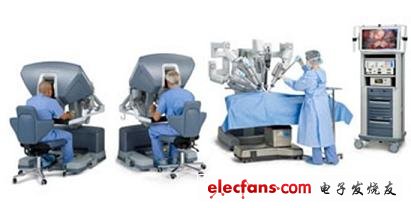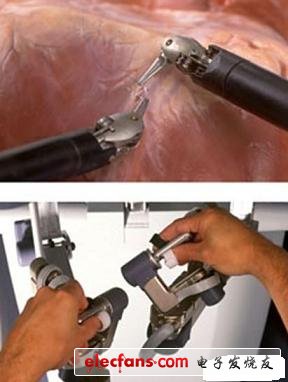Laparoscopic surgery is a type of surgical operation in which a long-handled instrument is inserted through a small incision into the patient's target area where surgery is required. Compared with traditional open surgery, laparoscopic surgery can shorten the recovery time, less pain, less adhesion, so that patients can have a better quality of life after surgery. However, manual laparoscopic surgery has many limitations, including the inability to perceive depth, the lack of control of the camera, the angle and space at which the tip of the instrument can rotate freely, and the extent to which doctors can move surgical instruments. These limitations can cause the surgeon to endure unnatural and painful surgical postures during the operation, which can lead to fatigue.
Robot-assisted laparoscopic surgery, such as the DaVinci system, allows the surgeon to sit on a stereo console and realize remote control of endoscopic surgical instruments through the robot arm beside the patient's bed. The DaVinci system consists of three parts: the surgeon ’s main console, a surgical cart for placing surgical instruments by the patient ’s bed, and imaging processing equipment. The system's three-dimensional visualization function can provide depth perception, and its miniaturized surgical instruments like wrist-shaped joints increase the surgeon's flexibility and range of motion. The system also strengthens the control of the surgical accuracy by reducing hand shake and providing the robotic arms with the surgeon ’s movements in proportion to the robotic arm. Compared with the manual laparoscopic surgery by the doctor, the ergonomic instrument-hand-eye combination and intuitive instrument movement can also shorten the training time of the surgeon.

The Da Vinci Si HD Surgical System shown in the figure is equipped with two surgeon main consoles, a patient surgical cart and a cart for placing the imaging equipment for displaying the surgical process.
The Da Vinci robotic surgery system is based on the robotic surgery technology developed by the Massachusetts Institute of Technology (formerly Stanford Research Institute). IntuiTIve Surgical then worked with IBM, MIT and Heartport to further develop the system. The FDA has approved the Da Vinci robotic surgery system for general surgery, thoracic surgery, urology, obstetrics and gynecology, head and neck surgery, and cardiac surgery for adults and children.
Da Vinci Robot
The Da Vinci surgical system requires up to five small (less than 1 cm) incisions in the patient's body for insertion of two surgical robotic arms and a camera. The supporting cart placed beside the patient's bed moves the surgical instruments to the patient's side, and there will be a surgical assistant next to the patient's bed. At the same time, the doctor can sit on the console of the room to operate the system, and the surgeon sees and feels the same as open surgery. The surgeon performs the operation by manipulating the master control device (for translating and transmitting the surgeon's movements to the robotic arm). The surgeon grasps the master control device below the display screen with his hand, and his wrist moves naturally with respect to his eyes. The surgeon's actions on the master control device are converted into precise, real-time robot arm actions performed within the patient's body.
The movement of the surgeon's wrists, hands and fingers to control the robot arm of the main knife is the same as a typical open surgery. In addition, the system also has a full range of EndoWrist surgical instruments to choose from. These surgical instruments can rotate at a 7-degree angle, which exceeds the dexterity of the human wrist. Each type of surgical instrument has a specific role, such as for clamping, suture surgery, and tissue processing.
The cart next to the patient is used to accommodate two robotic arms and an endoscopic arm, which are used to replicate the surgeon's movements. The laparoscopic arm uses the surgical site as a pivot and does not rely on the patient's body cavity wall for support, which will minimize damage to tissues and nerves. Surgeon's assistants have safe and suitable surgical instruments, prepare appropriate incisions on patients, and supervise the laparoscopic robotic arm and the tools being used.

In the picture above, the EndoWrist brake is being stitched. In the picture below, the surgeon is operating the main control device of the main console to guide the EndoWrist brake.
Braking design
The Da Vinci surgical system integrates high-end motion control technology, so that every movement of the robot arm can be as smooth and accurate as a skilled surgeon-even at a very slow calculation speed. Each DaVinci HD system contains more than 30 motors produced by Maxon Precision Motors. These motors are the heart of every robotic arm.
Maxon Motor provides input and output for the DaVinci system. Through a series of feedback controls, the motor and encoder receive the input signal from the doctor, and after real-time translation through the main console circuit, the output signal is transmitted to the motor in the robot arm. The manipulator then applies force back to the surgeon's hand through the main console circuit.
The stator of Maxon motor uses rare earth magnets, and the stator adopts iron-free design, so that even under low speed operation, there will be no magnetic cogging.
To distinguish their dual roles, the motor used by the surgeon's bedside cart is used as the master motor, and the motor used by the robot arm motor is used as the slave motor. The accuracy of the slave motor is the same as the accuracy of the master motor, and it also needs to be able to be driven backward when the surgeon assistant moves the end effector in place. The motor on the top of the surgical instrument has low hysteresis.
IntuiTIve engineers used more than 30 motors in the DaVinci system. There are RE25 motors, some with encoder feedback, and some motors without encoder feedback; RE 13 mm motors equipped with GP13 series reducers and 13 mm magnetic encoder; and RE 35 series motors with third-party encoders.
Mike Prindiville, general manager and manufacturing engineer of IntuiTIve Surgical, said that the Maxon motor is the key to the core performance test of the Da Vinci system. These core performance tests include friction, clearance and compatibility, and a series of sensor feedback monitoring.
M16 Circular Connectors,Ip68 M16 Waterproof Connector,M16 Metal Nut Round Waterproof Connector,M16 Waterproof Connector With Metal Nut
Shenzhen HuaTao Electronic Co., LTD , https://www.htconnector.com